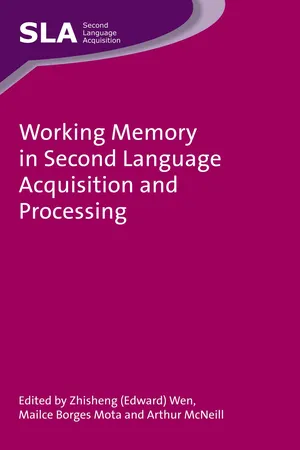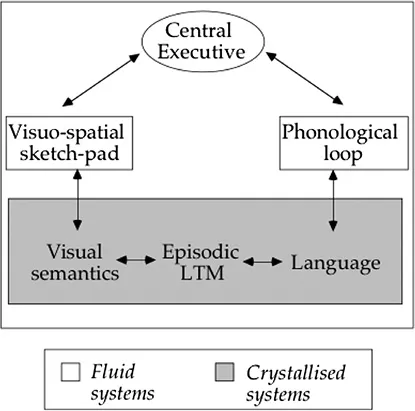![]()
Part 1
Theoretical Perspectives and Models
![]()
1 Working Memory in Second Language Learning
Alan Baddeley
Introduction
The multi-component model of working memory (WM) was developed with the dual aims of providing a framework for the basic understanding of human memory, and at the same time providing a bridge to application beyond the laboratory. One of the earliest and, in my view, most successful of such applications was to language learning, principally to the acquisition and development of vocabulary in children (Baddeley et al., 1998), and also to second language learning (Atkins & Baddeley, 1998). As is clear from the current volume, research on WM and second language learning has flourished in the years since my own rather minimal involvement, and hence I was delighted to hear of the present enterprise, and to lend my support through writing this introductory chapter to express my speculative thoughts on the possible implications of the multi-component view of WM for second language learning.
While it would have been very nice to read the contributions and subsequently comment on them, the timing clashed with the process of revising and updating our memory text (Baddeley et al., 2015). My initial agreement was to write a Preface that envisaged little more than enthusiastic support of this particular application of the WM model. I was, however, tempted by the editor’s suggestion that I might outline the current state of the multi-component model, and in doing so thought it would be interesting to think about second language learning and speculate as to how the various current components of the model might be involved. I should emphasise, however, that what follows is simply a brief account of the current model (a more extended discussion can be found in Baddeley [2012]), together with some initial thoughts that may well be proved misguided by the chapters that follow. If so, I shall simply fall back on the observation that progress is often made by discovering points where our predictions are clearly wrong.
Evolution of the Multi-Component Model
Our WM model has its roots in the proposal that short-term memory (STM), principally verbally based, played a useful role in cognition more generally, a view first presented by Broadbent (1958) and developed much more extensively by Atkinson and Shiffrin (1968). Our own work (Baddeley & Hitch, 1974) was prompted by difficulties encountered by this approach in dealing both with links to long-term memory (LTM) and with data from patients whose impaired verbal STM had surprisingly little impact on their broader cognition. Our own studies, relying heavily on dual task methods, led us to propose the model shown in Figure 1.1, which assumes an attentionally limited control system, the central executive, aided by two temporary storage systems, one specialised for acoustic and language stimuli, and the other counterpart the visuospatial sketchpad.
Further development was spurred by the challenge of finding an evolutionary function for the phonological loop that might prove more plausible than remembering telephone numbers. Our search was helped by access to a patient, PV, with a very pure phonological loop deficit. We first tested the hypothesis that the loop was necessary for language comprehension, but found little evidence of impairment, except for certain convoluted sentences explicitly designed to rely on the phonological loop (Vallar & Baddeley, 1987). We then tested the hypothesis that the phonological loop might have evolved for language acquisition, finding that our patient was greatly impaired in acquiring vocabulary in a foreign language, Russian (Baddeley et al., 1988). We went on to show that procedures interfering with the phonological loop function disrupt the acquisition of foreign language vocabulary but not memory for meaningful word pairs in healthy participants (Papagno et al., 1991), and that polyglots who have acquired several languages tend to show enhanced phonological loop capacity (Papagno & Vallar, 1995), while otherwise extremely able people with a reduced verbal STM also tend to have difficulty in acquiring foreign vocabulary (Baddeley, 1993). Furthermore, extensive research by Susan Gathercole and myself has shown a clear link between native language vocabulary learning in children and phonological memory (see Baddeley et al. [1998] for a more detailed account).
Figure 1.1 The original Baddeley and Hitch (1974) working memory model
As a result of this line of work, we modified the basic model to that shown in Figure 1.2. The principal difference is a clear link between the phonological loop and phonological LTM, a link that operates in both directions; the phonological loop facilitates the acquisition of new words, and in due course the richer the available array of existing words, the easier it is to use these to help acquire new items. We speculate that a similar link will occur between the sketchpad and visuospatial semantics, although this has been little investigated so far.
The next version of the model was also driven by the study of language and, in particular, the very strong relationship between prose comprehension and the WM span measure originally developed by Daneman and Carpenter (1980). They presented their participants with sequences of sentences to read, subsequently asking them to recall the last word of each. This and other complex span measures, not necessarily involving language, have proved to be very powerful predictors not only of comprehension (Daneman & Merike, 1996), but also of cognitive processing more generally, including measures of intelligence (see Engle et al. [1999] for a review).
Daneman and Carpenter explicitly based their test on the requirement to combine the storage and processing of information, as in our original model. We were therefore delighted that it proved so successful, but worried by the implications it had for our model, as it existed at the time. This concerned our assumptions regarding the central executive. Initially, it had been assumed to be capable of combining both storage and attentional processing, an assumption that was so broad and unconstrained that it effectively became a homunculus, the little man who could do everything that might create problems for the model. This presented a problem. Homunculi are good servants but bad masters; if our homunculus was able to do everything, how could it be tested and how could the theory be developed? Homunculi can, however, be useful if constrained by specifying exactly what tasks they are to perform, and then attempting to explain each of these in turn. When all are explained, the homunculus can be retired.
Figure 1.2 A modification of the original model to take account of the evidence of links between WM and LTM
We began by removing the storage role of the executive, assuming that it is a purely attentional system (Baddeley & Logie, 1999). Unfortunately, this assumption created difficulty in trying to explain just how our model provided the substantial storage needed by the Daneman and Carpenter (1980) WM span task, since neither the phonological loop nor the sketchpad has enough storage capacity to hold entire sentences. Faced with this dilemma, I finally added a fourth component, the episodic buffer (Baddeley, 2000). This is assumed to be a multidimensional storage system, capable of combining information from the visuospatial and verbal subsystems and linking it with further information from perception and LTM. It was assumed to hold a limited number of episodes (cf. Cowan, 2005), with each episode binding together information from these various sources into unified chunks. Finally, the buffer was assumed to be accessible to conscious awareness, and indeed to be the basis of conscious awareness which, like Baars (2002), I proposed serves the specific function of binding together information into consciously experienced arrays or episodes. A problem with this ambitious speculation is the danger that it simply becomes another homunculus, all powerful but untestable. The next stage in collaboration with Graham Hitch and Richard Allen has been to demonstrate that this is not the case.
The 2000 model was explicitly designed with the assumption that the episodic buffer was under the strict control of the central executive, just a short but important step from our original all-purpose homunculus. We chose to focus on the process of binding features into the chunks stored in the buffer, using our dual task methods to block the various components of the model, and in particular the central executive. Our initial speculative model predicted that without the strong support of the executive, such binding would break down. We looked at both the binding of colours and shapes into visual objects, and also at the binding of words into the chunks that occur in remembering meaningful sentences. This is a very powerful effect, with memory span for unrelated words being around 5, and for meaningful sentences around 15 words. We argued that if the executive is needed in order to perform this binding, then a demanding attentional task should interfere with binding and hence reduce the sentence advantage. This did not happen; an attentional task like concurrently counting backwards reduced overall performance, but had no impact on the difference between recall of unrelated words and sentences. We concluded that the advantage from the semantic and syntactic constraints of sentences came from LTM and was relatively automatic (Baddeley et al., 2009b). An exactly equivalent story came from our study of the binding of features into objects (Allen et al., 2006). We concluded that the episodic buffer is an important but passive store, capable of holding bound episodes, but not itself performing a binding function. We suggest that binding is likely to happen in different ways for language and vision, using different systems at different brain locations. It appears to function as a passive store rather than an attentionally dependent component of WM.
Our current, now rather more complex model is shown in Figure 1.3. It still has the three original basic components, with the addition of a fourth, the episodic buffer. The phonological and visuospatial subsystems feed into the buffer, and are themselves envisaged...


